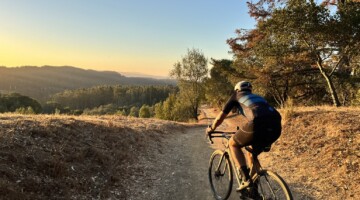An offshoot of the all-road approach is the aero gravel bike designed for racing fast at events such as the Dirty Kanza 200 and Gravel Worlds where the courses feature long grinds on flat and rolling terrain. It’s a sub-discipline for sure, but a growing one.
A pioneer in aero gravel bikes has been Italy’s 3T. 3T was founded in 1961 with a focus on lightweight, aero components such as handlebars, stems and seatposts. A few years ago, it decided to bring that same approach to making bikes.
Former Cervelo designer and Open Cycles co-founder Gerard Vroomen recently took a controlling interest at 3T, and in 2016, the company introduced its first bike in the aero Exploro gravel bike. The bike has already made a mark on U.S. gravel, with Mat Stephens winning the 2017 Dirty Kanza 200 on an Exploro. We have also profiled his Panaracer teammate Kae Takeshita’s Exploro.
This summer we received an Exploro of our own for mixed-terrain testing on the West Coast. Find out how it performed in this review.
[caption id="attachment_137637" align="aligncenter" width="1140"]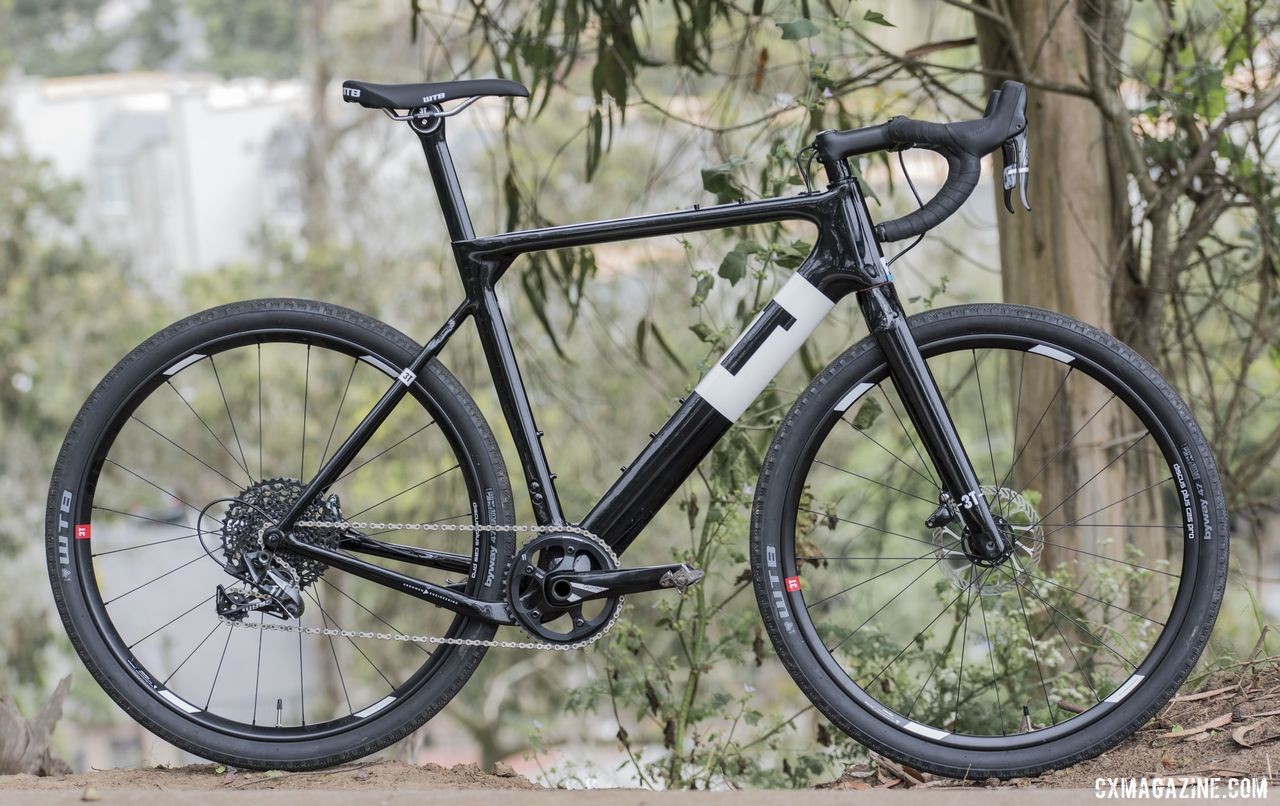 3T Exploro Team Force Gravel Bike. © C. Lee / Cyclocross Magazine[/caption]
3T Exploro Team Force Gravel Bike. © C. Lee / Cyclocross Magazine[/caption]
The Frame
When designing the Exploro, 3T took the commitment to building an aero bike seriously. The truncated airfoil tube shapes were wind tunnel tested at the San Diego low-speed wind tunnel.
Monocoque carbon construction with the aforementioned truncated aerodynamic section tubes gives the 3T Exploro a bold look. The head tube blends into the large down tube. The airfoil-shaped down tube has the tapered portion truncated, leaving a flat surface ideal for the down tube bottle mounts.
The down tube’s leading edge is a very large 51mm, but the fore-aft cross-section is longer at 72mm. The idea is the down tube needs to be large enough to catch the airflow behind the wide front tire. The truncation of the airfoil is more for practical reasons. To have ideal airfoil proportions, the down tube would be so deep it would close the main triangle.
[caption id="attachment_137635" align="aligncenter" width="1140"]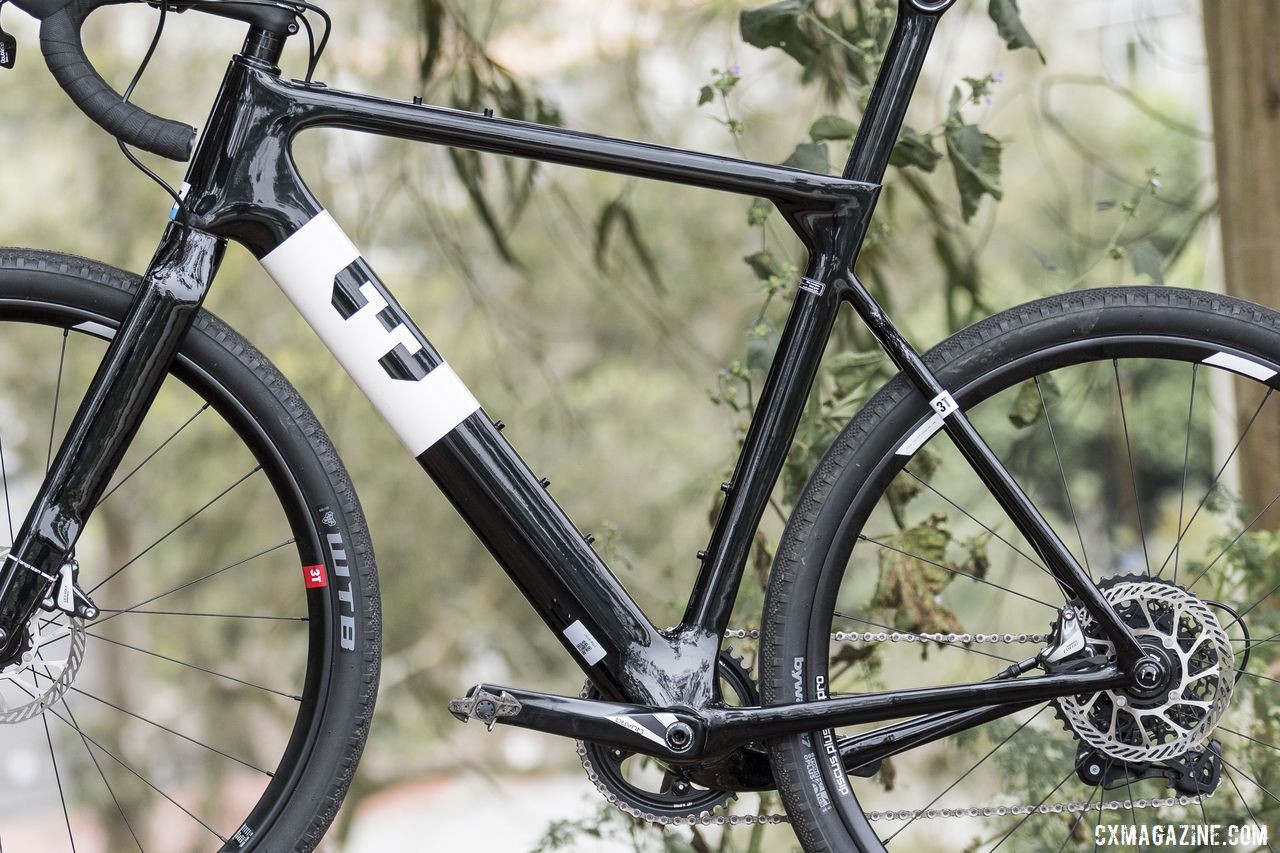 The down tube 72mm wide longitudinally to help provide an aero boost. 3T Exploro Team Force Gravel Bike. © C. Lee / Cyclocross Magazine[/caption]
The down tube 72mm wide longitudinally to help provide an aero boost. 3T Exploro Team Force Gravel Bike. © C. Lee / Cyclocross Magazine[/caption]
The top tube tapers from the wide head tube toward the slender seat tube, which also has an airfoil shape. The seat tube backside is also flat to fit the rear tire and wheel and keep the chainstays short. The seatpost has a matching airfoil shape and is held in place by a wedge that tightens from the top of the top tube. The wedge mechanism is separate from the frame, so without the seatpost in place, the wedge mechanism can fall out and be lost in shipping, as was ours. 3T sells spares, fortunately.
[caption id="attachment_137632" align="aligncenter" width="1140"]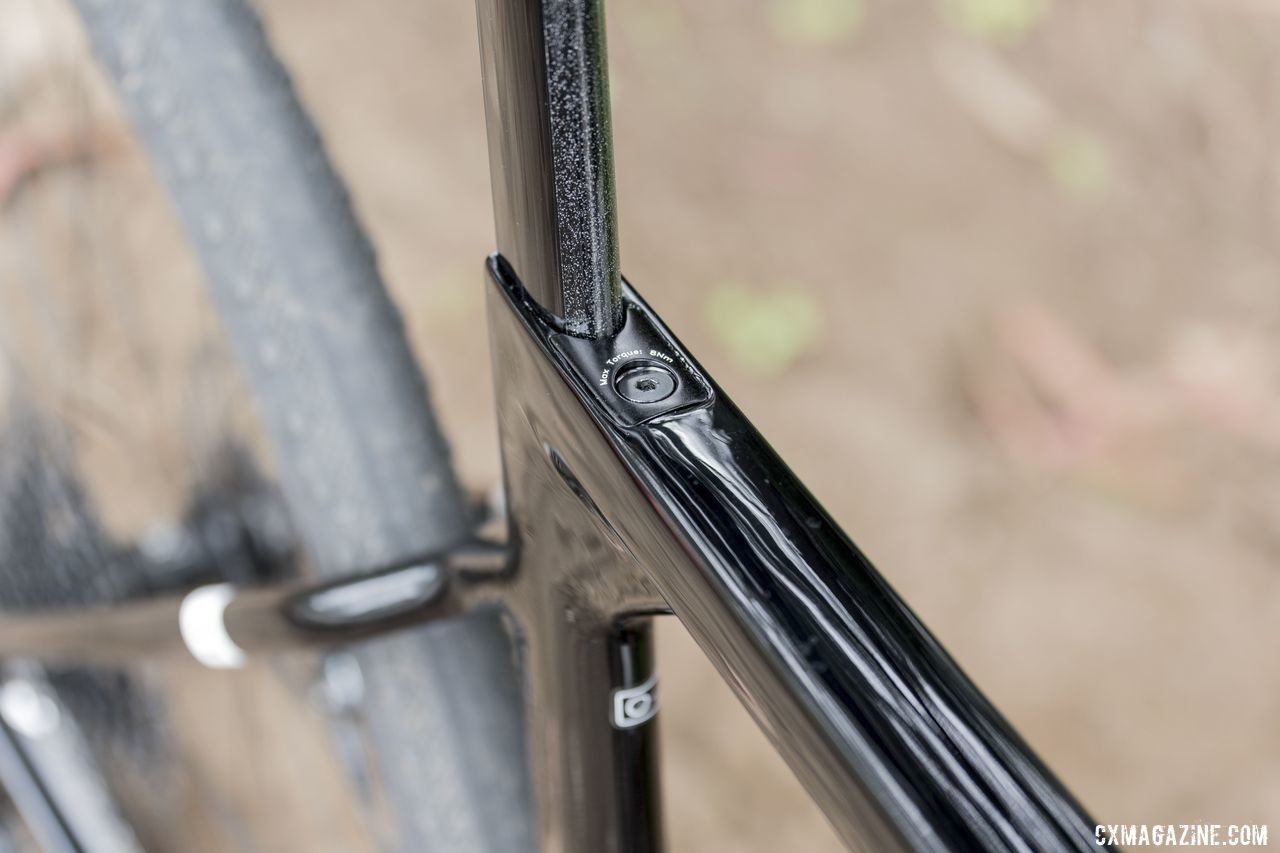 A wedge mechanism helps clamp the seatpost in place. 3T Exploro Team Force Gravel Bike. © C. Lee / Cyclocross Magazine[/caption]
A wedge mechanism helps clamp the seatpost in place. 3T Exploro Team Force Gravel Bike. © C. Lee / Cyclocross Magazine[/caption]
The seatpost clamp is a unique nesting ring mechanism. Two rings with teeth nestle one within the other and within the seatpost. Rotation of one ring with respect to the other yields saddle tilt increments of 0.5 degrees. The nature of this design avoids saddle angle slippage. Saddle fore-aft adjustment is independent.
[caption id="attachment_137633" align="aligncenter" width="1140"]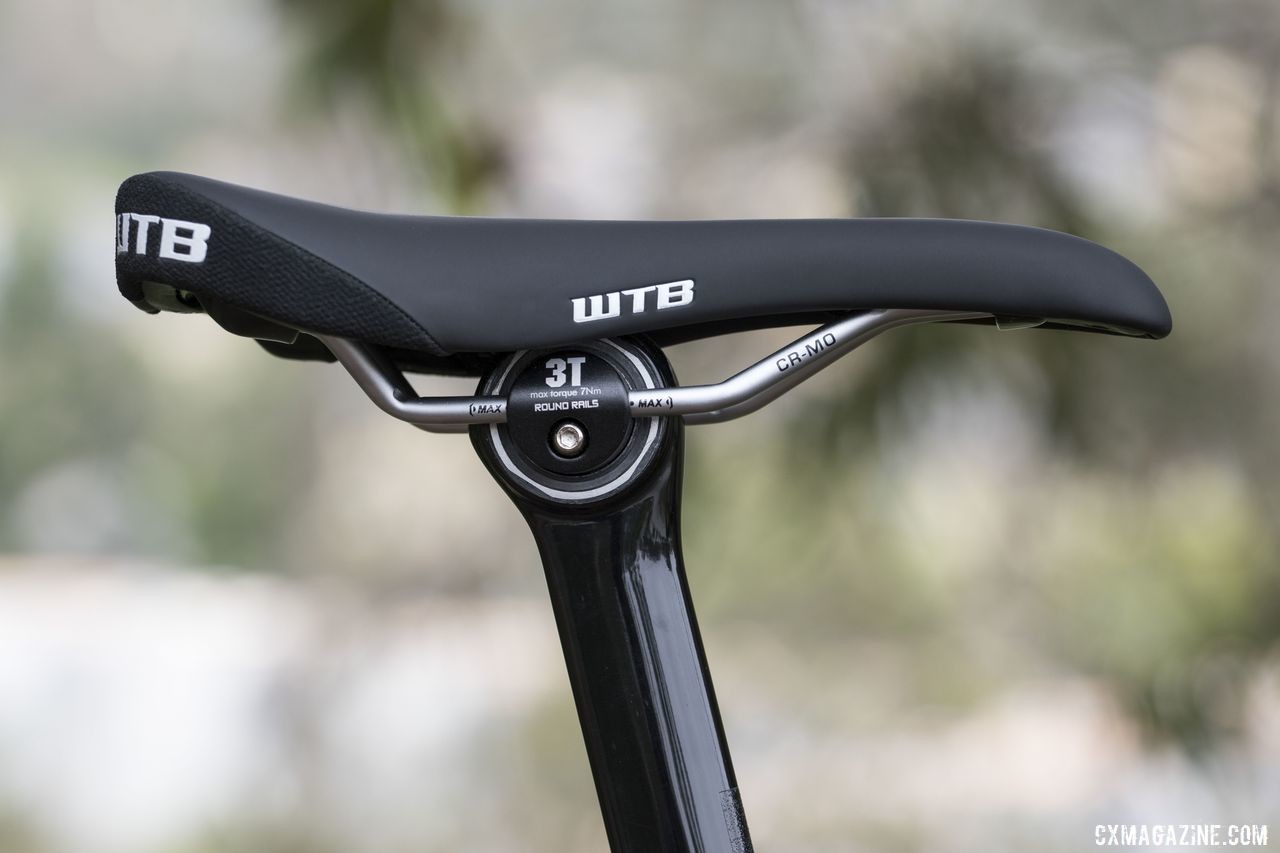 The Exploro aero seatpost uses a vernier system to dial in seat angle. We did not experience any slipping. 3T Exploro Team Force Gravel Bike. © C. Lee / Cyclocross Magazine[/caption]
The Exploro aero seatpost uses a vernier system to dial in seat angle. We did not experience any slipping. 3T Exploro Team Force Gravel Bike. © C. Lee / Cyclocross Magazine[/caption]
The geometry of the Exploro is similar to a road bike with parallel 72.5-degree head and seat tube angles and short 41.5cm chainstays. The top tube on our size L frame is a rangy 57.1cm, which gives a 39.0cm reach. However, the steep head tube angle yields a front center of 60.2cm, closer to what we often see on a similarly-sized cyclocross bike.
Vroomen solved the problem of tire clearance with the relatively short 41.5cm chainstays by dropping the drive-side chainstay. The first iteration of this design from Vroomen was the Open Cycles U.P. The 7.0cm bottom bracket drop of the Exploro is fairly standard for the gravel category.
[caption id="attachment_137634" align="aligncenter" width="1140"]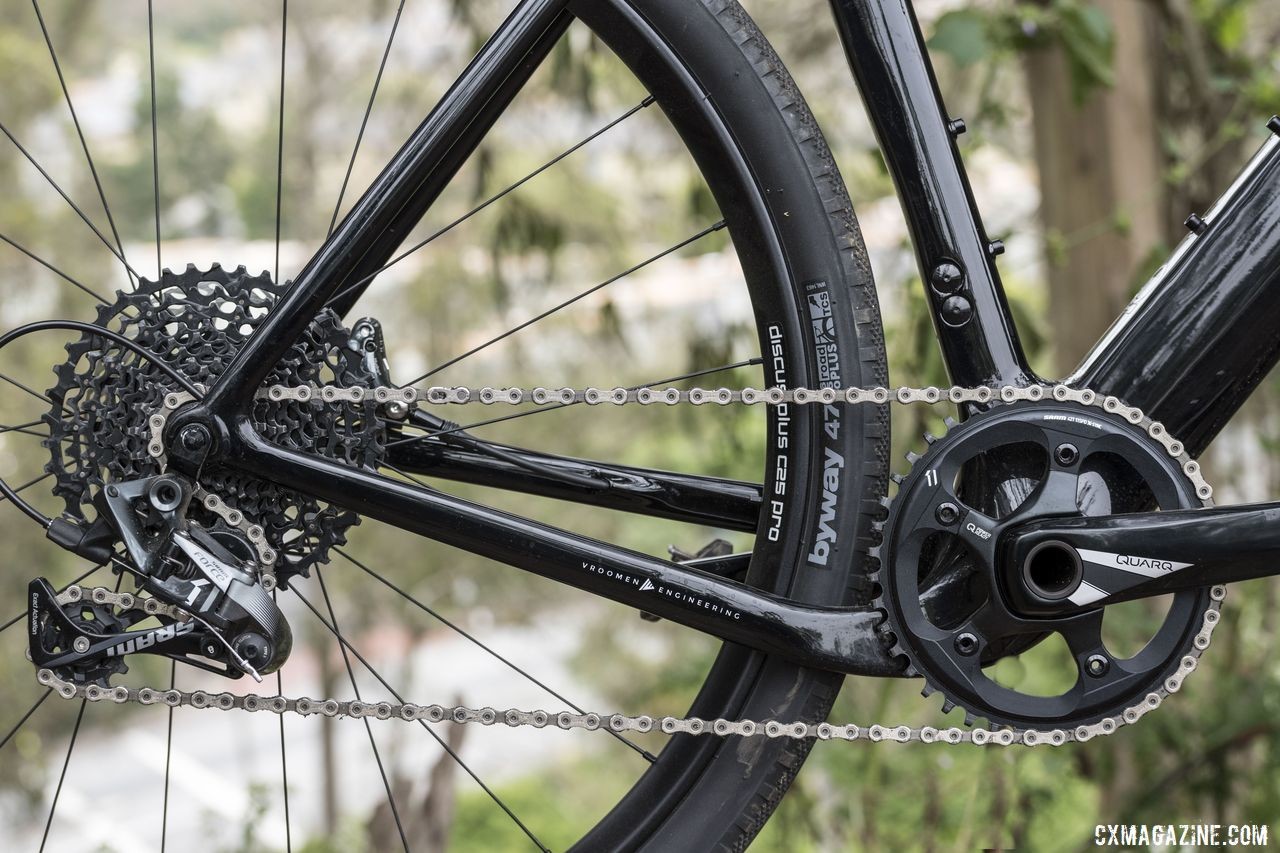 The Exploro features a dropped drive-side chainstay to provide extra tire clearance with the short chainstays. 3T Exploro Team Force Gravel Bike. © C. Lee / Cyclocross Magazine[/caption]
The Exploro features a dropped drive-side chainstay to provide extra tire clearance with the short chainstays. 3T Exploro Team Force Gravel Bike. © C. Lee / Cyclocross Magazine[/caption]
The rear derailleur control line runs a full length of housing from the lever to the rear derailleur. If using a front derailleur, the cable housing stops at the entry into the top tube and runs naked through the frame. The control lines enter at the top of the top tube through an interchangeable cap. Different caps are available, configured for electronic or cable shifting, front derailleur or not.
The Exploro has 12mm thru-axles in the standard widths, 100mm front and 142m rear. The rear derailleur hanger is held on by the rear thru-axle. When the rear thru-axle is removed, the rear derailleur hanger, with the rear derailleur attached to it, separates from the frame.
3T’s idea here is to make removal and replacement of the disc brake rear wheel easier with the rear derailleur and chain out of the way. When replacing the rear wheel, it is a simple matter of holding the rear derailleur in place as you thread the axle into the hanger. In experience, this neither easier nor harder, though I can appreciate that aligning the rotor into the caliper is less complicated without the need to simultaneously align the chain and cogs.
There are two bottle cage mounts in the usual place of down tube and seat tube. The down tube mounts have three bolts for either a long cargo cage or varied bottle cage placement. There are also top tube mounts for a top tube “Bento box” bag. There are no fender mounts or additional rack mounts in the rear or on the fork.
The carbon fork has a tapered steerer tube 1 ⅛” to 1 ½” with a loose ball bearing headset. The axle-to-crown distance is 395mm and the fork has a 50mm rake. The blades are flat and asymmetric—the left blade with the flat-mount brake caliper is thicker—and the minimum rotor size is 140mm. Calculated trail with the 72.5-degree head angle with the 50mm fork offset and a 650b x 47mm tire is 56mm. This figure is the same with 700c x 30mm since the rolling diameter is the about the same.
[caption id="attachment_137641" align="aligncenter" width="1140"]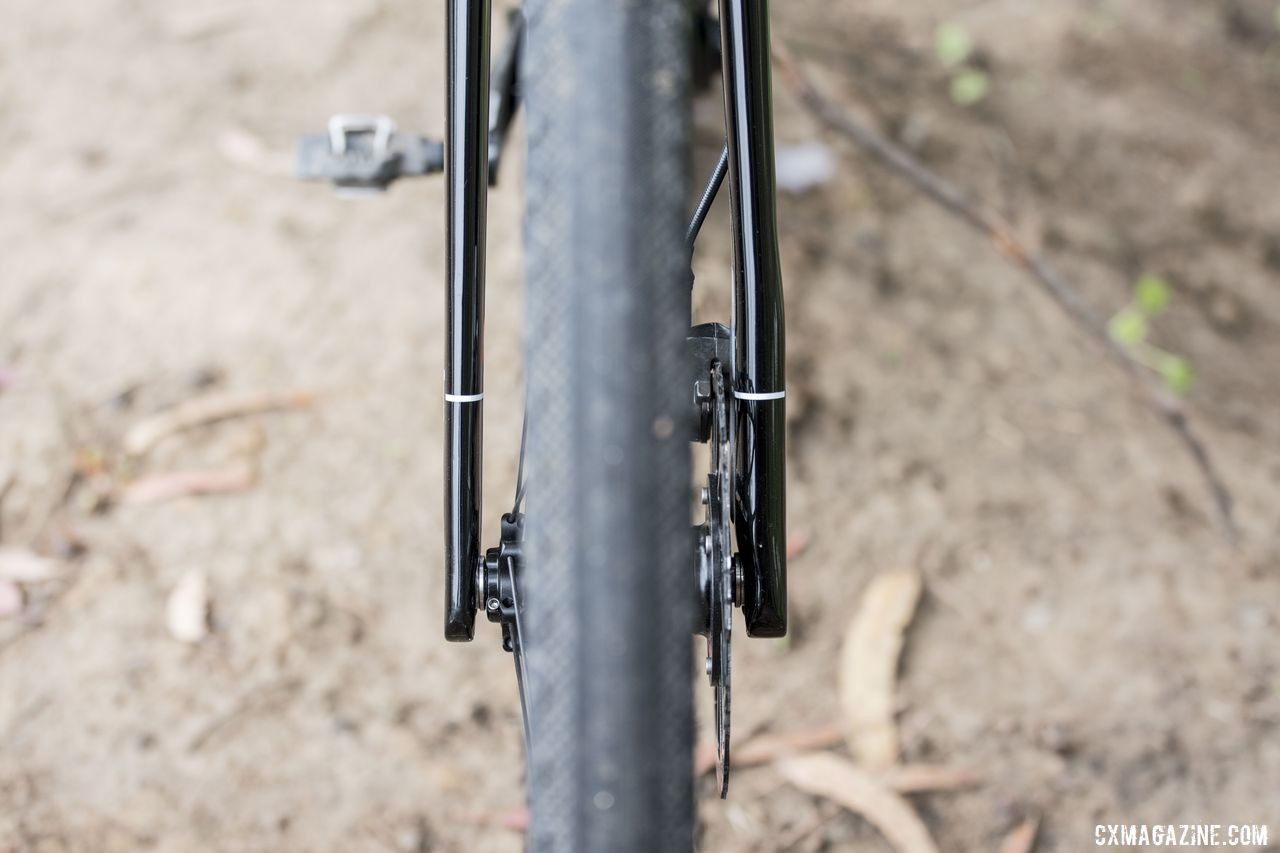 The fork blades are flat and asymmetric, with the caliper side a bit thicker. 3T Exploro Team Force Gravel Bike. © C. Lee / Cyclocross Magazine[/caption]
The fork blades are flat and asymmetric, with the caliper side a bit thicker. 3T Exploro Team Force Gravel Bike. © C. Lee / Cyclocross Magazine[/caption]
The Exploro frameset is designed to fit 650b x 2.1″ or 700c x 40mm tires comfortably.
[caption id="attachment_137636" align="aligncenter" width="1140"]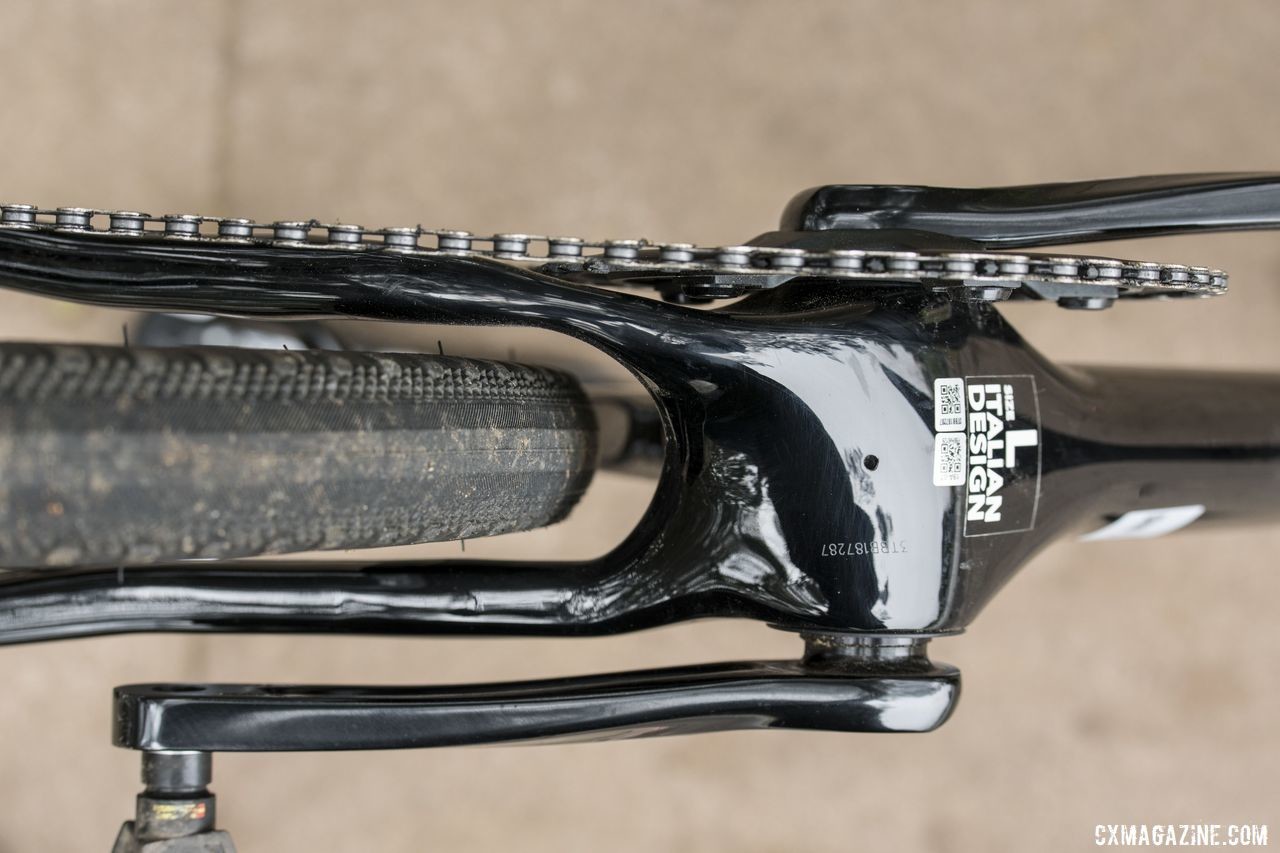 The 3T Exploro frame has clearance for tires up to 650b x 2.1″ or 700c x 40mm. 3T Exploro Team Force Gravel Bike. © C. Lee / Cyclocross Magazine[/caption]
The 3T Exploro frame has clearance for tires up to 650b x 2.1″ or 700c x 40mm. 3T Exploro Team Force Gravel Bike. © C. Lee / Cyclocross Magazine[/caption]
The Build
3T offers a lot of options for configuring the Exploro, with 9 different builds and 2 framesets. Some of the configurations are “Speed” models equipped with 700c wheels and narrower tires.
Our size L sample was the Exploro Team Force build with 650b wheels. At $4,200, it is the least expensive build.
The Exploro Team Force has a SRAM Force 1 drivetrain with a Force 1 carbon crank and a 42t X-Sync chain ring. The Force 1 rear derailleur shifts over the 11-speed 11-42t Powerglide cassette, giving a 1:1 low gear ratio. SRAM Force hydraulic flat mount calipers stop with Avid G3 Clean Sweep 160mm rotors front and rear.
The handlebar and stem are 3T aluminum, a 42 cm width bar combined with a 100mm stem on the size L bike. The 3T Apto Pro stem faceplate bolts hold the faceplate from the backside, making for a more aerodynamic arrangement. The bolts thread into a blind hole, so bolt length is critical to assure a tight handlebar should you lose the original bolts.
[caption id="attachment_137638" align="aligncenter" width="1140"]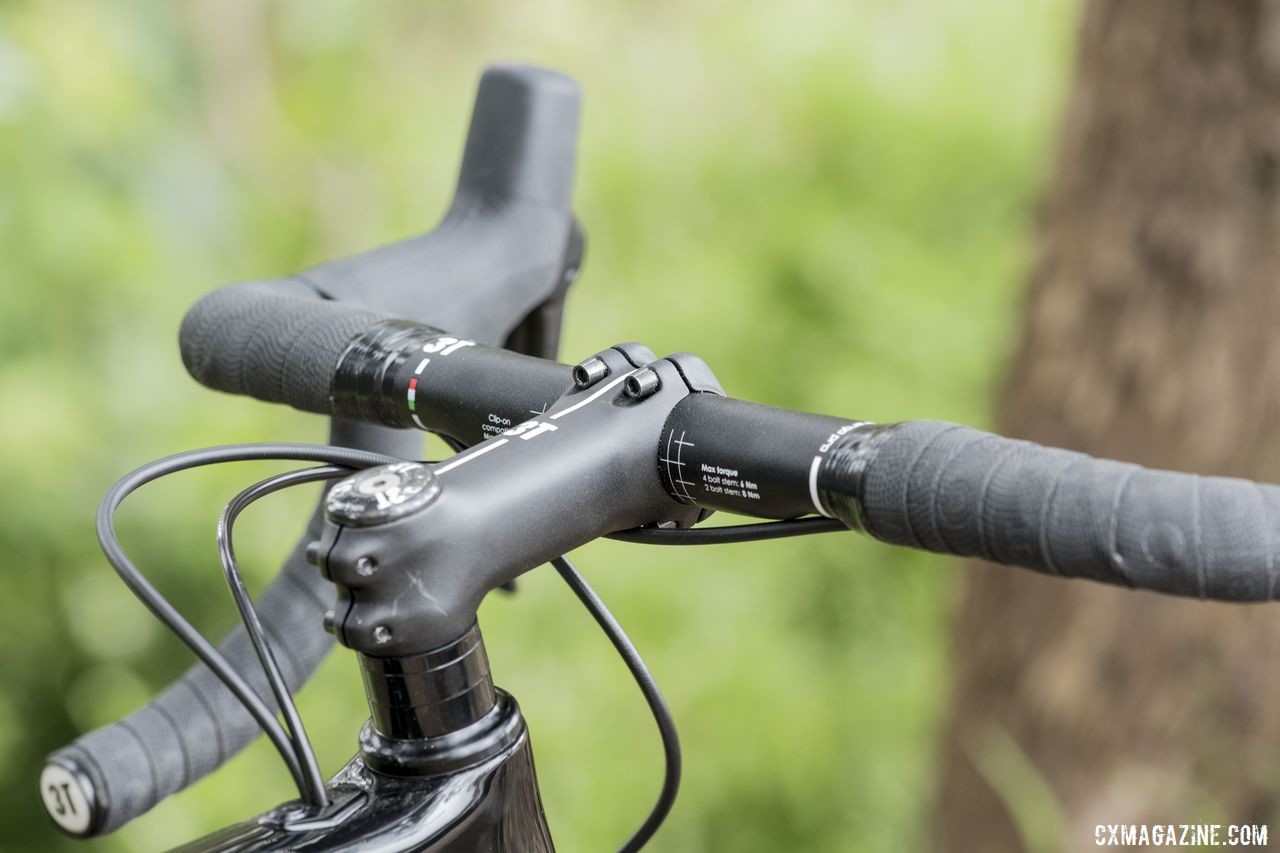 A 3T stem and handlebar make up the cockpit. 3T Exploro Team Force Gravel Bike. © C. Lee / Cyclocross Magazine[/caption]
A 3T stem and handlebar make up the cockpit. 3T Exploro Team Force Gravel Bike. © C. Lee / Cyclocross Magazine[/caption]
The 3T carbon aero seatpost is unique to the Exploro with an aero-optimized design.
The Team Force build comes with 650b wheels. Our bike had 3T Discus Plus C25 650b aluminum tubeless clinchers that have a claimed weight of 1,685 grams. The Discus Plus C25 rim has a 24mm inner width and a 30mm outer width with asymmetric drilling to equalize spoke bracing angles. The 3T Discus hubs use 24 straight-pull, double-butted (2.0/1.8/2.0) spokes laced 2x for both front and rear wheels. Our build included WTB Byway TCS 650b x 47mm tires.
[caption id="attachment_137630" align="aligncenter" width="1140"]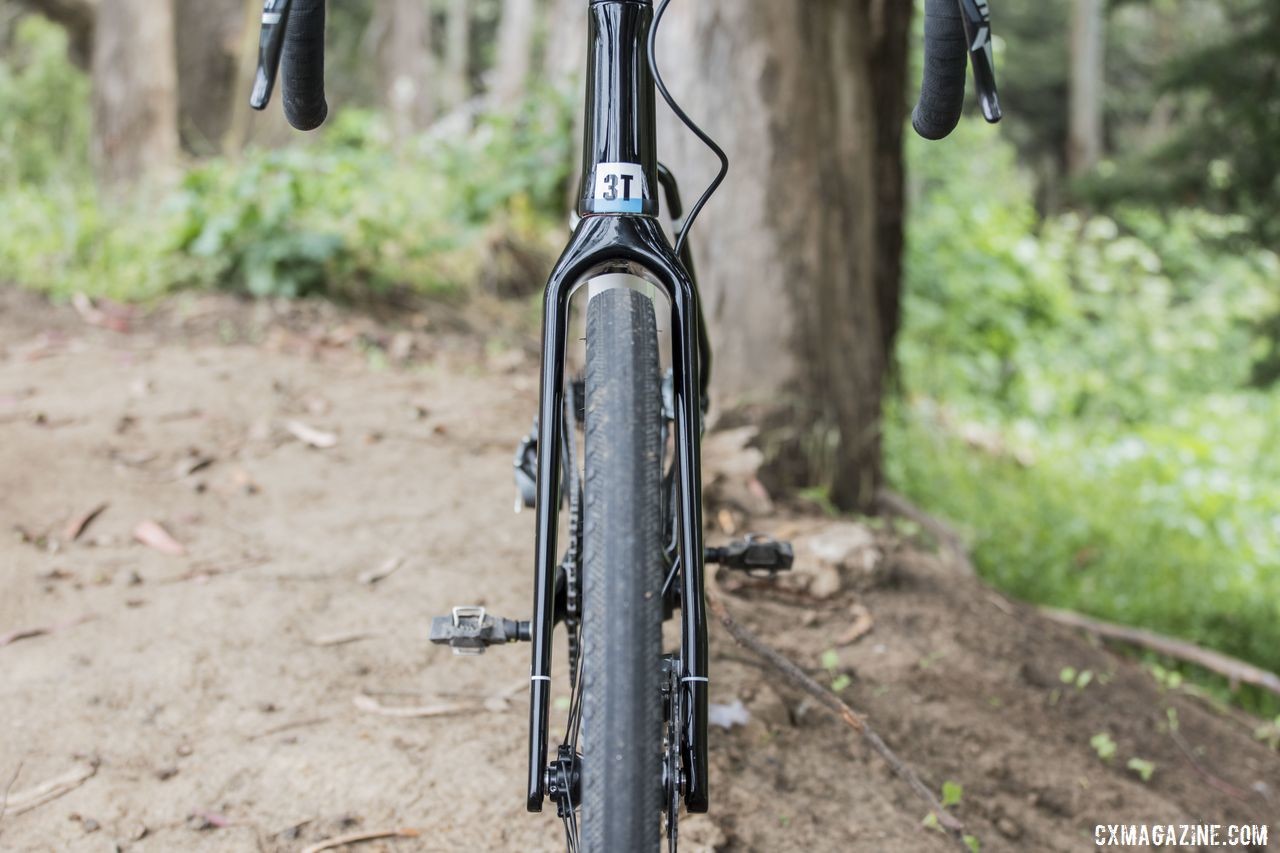 The fork has plenty of clearance for the 650b x 47mm WTB Byway tires. 3T Exploro Team Force Gravel Bike. © C. Lee / Cyclocross Magazine[/caption]
The fork has plenty of clearance for the 650b x 47mm WTB Byway tires. 3T Exploro Team Force Gravel Bike. © C. Lee / Cyclocross Magazine[/caption]
The 3T Exploro Team Force as we tested it is 20.2 pounds complete, 11.4 pounds without wheels. The retail price is $4,199.
The Ride
Before discussing the ride of the 3T Exploro, it is worth noting the conditions under which I tested it. I live in California, so mixed-terrain riding includes rocky descents, some singletrack, fire roads and a decent amount of elevation change. These conditions might not be exactly what the aero Exploro race bike was designed to take on.
First ride impressions revealed a stiff frame with quick steering that responded to the slightest input. The stiffness of the Exploro is noticeable both in stand-up pedaling and over rough terrain. The stiffness helps overcome the heft of the bike and wheels to aid in climbing and acceleration. That adds appreciated liveliness to the ride.
The ultra-responsive steering was deleterious to ride quality when I hit any sections with large gravel or gnarly terrain. You can compensate with lower pressure in the wide tires, but that only helps so much, and more bounce or tire deflection adversely affects handling.
Aero section tubes and seatposts have adversely affected compliance in the road bike sector, and the design of the Exploro magnifies the effect off-road on rough surfaces. On steeper descents, the stiff ride of the 3T Exploro contributed to me descending long, bumpy descents without much confidence.
Quick steering and stiffness provide a racy feel during a short cyclocross race, but for long gravel rides with gear loaded up, those factors contribute to a ride that is more mentally and physically fatiguing.
[caption id="attachment_137648" align="aligncenter" width="1140"]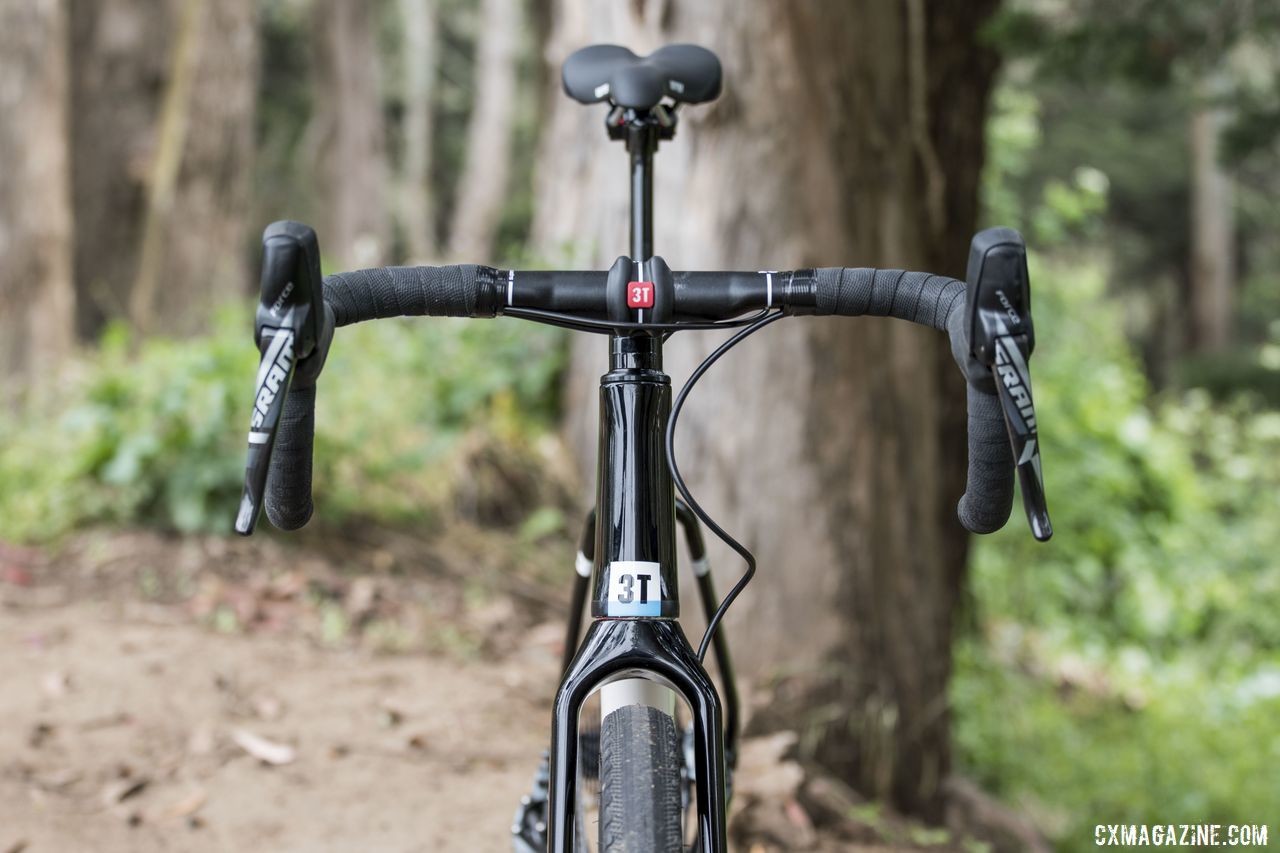 The front end provides quick steering. 3T Exploro Team Force Gravel Bike. © C. Lee / Cyclocross Magazine[/caption]
The front end provides quick steering. 3T Exploro Team Force Gravel Bike. © C. Lee / Cyclocross Magazine[/caption]
Building bikes with 650b wheels to gain the room for a fatter tire is not new, and Vroomen helped popularize the approach with his designs of the Open Cycles U.P. and 3T Exploro. What we used to call monster cross has become the norm and the lines between a hardtail cross country mountain bike and cyclocross bike have blurred considerably.
With the Exploro, Vroomen tries to combine road bike geometry with mountain bike tires and I’m not sure it works for my terrain or type of riding. On the road, the 47mm tires felt a bit sluggish during accelerations primarily due to the weight of the wheel/tire package (not necessarily the width of the tire). If was to do more Midwest-style gravel races or off-road pack riding, the Exploro would likely be a fine choice.
The WTB Byway has a smooth tread, so once up to speed, the bike rolls well. The inertia of the 1,700-gram wheels with 1000 grams of tire gives the bike straight-ahead stability, with the wide tires absorbing imperfections in the surface, adding to the feeling of stability.
The Exploro has 56mm of calculated trail. A typical cyclocross race bike is 66mm and a typical road racing bike is 62mm. The short trail on the Exploro—perhaps attempting to overcome the inertia of the big heavy tire and wheel combination—produces a twitchy front end.
[caption id="attachment_137642" align="aligncenter" width="600"]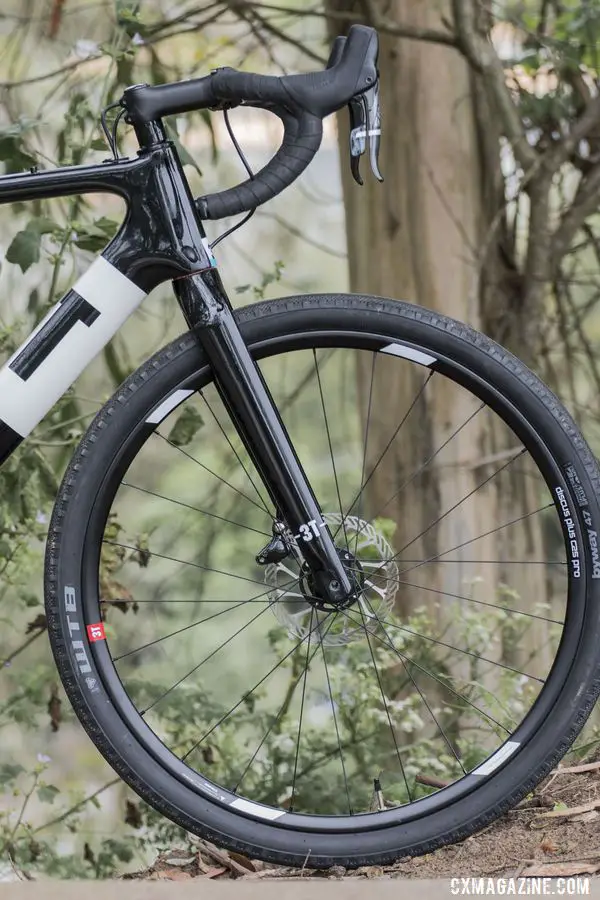 The front end of the Exploro has a short trail, which affects ride quality off-road. 3T Exploro Team Force Gravel Bike. © C. Lee / Cyclocross Magazine[/caption]
The front end of the Exploro has a short trail, which affects ride quality off-road. 3T Exploro Team Force Gravel Bike. © C. Lee / Cyclocross Magazine[/caption]
The design feels similar to a quick criterium-oriented road bike. Off-road I’m not sure I like that so much since surface deflections will knock steering off line. Corrections led to more over-corrections with the quick steering quality, requiring more work to keep the bike going straight. Of course, at higher speeds the bike stays straighter due to momentum and inertia of the wheels.
Riding the Exploro, it is apparent the bike is designed for long gravel grinds. In those conditions, the bike performs admirably, and it is certainly a bike I would think about choosing should I win the Dirty Kanza 200 lottery.
During off-road riding closer to home, I prefer a bike that requires a little less attention and will not get knocked around as easily. Head down a steep descent on the Exploro and the short trail makes the experience hair-raising, especially if there is not a straight, regular run-out. On one sustained 20% loose fire road descent that ends on a loose bumpy curve, the experience was dicey, which is not the case with a bike with more trail such as the Kona Major Jake or the Look 765 gravel bike.
Even though it’s an aero gravel bike designed to go fast, on tight, technical singletrack, the Exploro is actually quite fun. Sure, it’s stiff and it’s highly capable navigating through tight switchbacks and up short, steep climbs. Sure, the aero shapes add little value at such speeds, but the tight geometry and fast steering feel at home when line choice or weighted rear wheels matter.
We’d even consider the Exploro for an early season “grass crit” cyclocross race.
The Verdict
The 3T Exploro is ground breaking with a tested aerodynamic design and Dirty Kanza 200 palmares. Whether or not the Exploro is a good fit for you is likely ultimately going to be about what kind of gravel riding you do.
If you are looking for a gravel bike to grind away at high speeds on endless gravel roads, the aero design of the Exploro provides road efficiency and speed while offering some off-road capability when roads get dicey. If being at the pointy end of gravel race is your goal, the Exploro may offer a few extra watts to help you get there. If you want your gravel rig to double as a fast road bike, the Exploro might hit the mark.
If your gravel riding is more of an adventure where comfort and stability are a must, the Exploro will likely be a bit out of its element. There is a lot to like about the Exploro, and the addition of a slacker front end and more compliance could help make it more versatile while maintaining the aerodynamics and tire versatility.
For a closer look at the 3T Exploro Team Force gravel bike, see the specs and photo gallery below.
3T Exploro Team Force Gravel Bike Specs
MSRP: $4,200 USD
Frame: Exploro TEAM, high-modulus uni-directional pre-preg carbon fiber monocoque
Fork: 3T Fango TEAM, carbon fiber with carbon steerer: 1 ⅛” -1 ½”
Weight: 20.1 pounds, no pedals; 11.4 lbs without wheels or pedals
Shift/Brake Levers: SRAM Force 1 hydraulic, 11-speed
Brakes: SRAM Force 1 hydraulic, flat mount disc
Rotors: Avid G3 Clean Sweep, 160mm front, 160mm rear
Crankset: SRAM Force 1, Quarq power ready
Chain Ring: SRAM X-Sync, 42t
Rear Derailleur: SRAM Force 1
Cassette: SRAM Powerglide 11-42t
Wheels: 3T Discus Plus C25 alloy tubeless clinchers, 650b
Tires: WTB Byway, 650b x 47mm, tubeless
Stem: 3T Apto Pro, aluminum, 100mm
Handlebar: 3T Superergo, aluminum, 42cm
Seatpost: 3T carbon aero
Saddle: WTB Volt, steel rails
Warranty: 2 years frame and fork, 5 years if registered within 30 days of purchase
Country of origin: Taiwan
More Info: 3t.bike
[otw_is sidebar=otw-sidebar-1]
Photo Gallery: 3T Exploro Team Force Gravel Bike



























